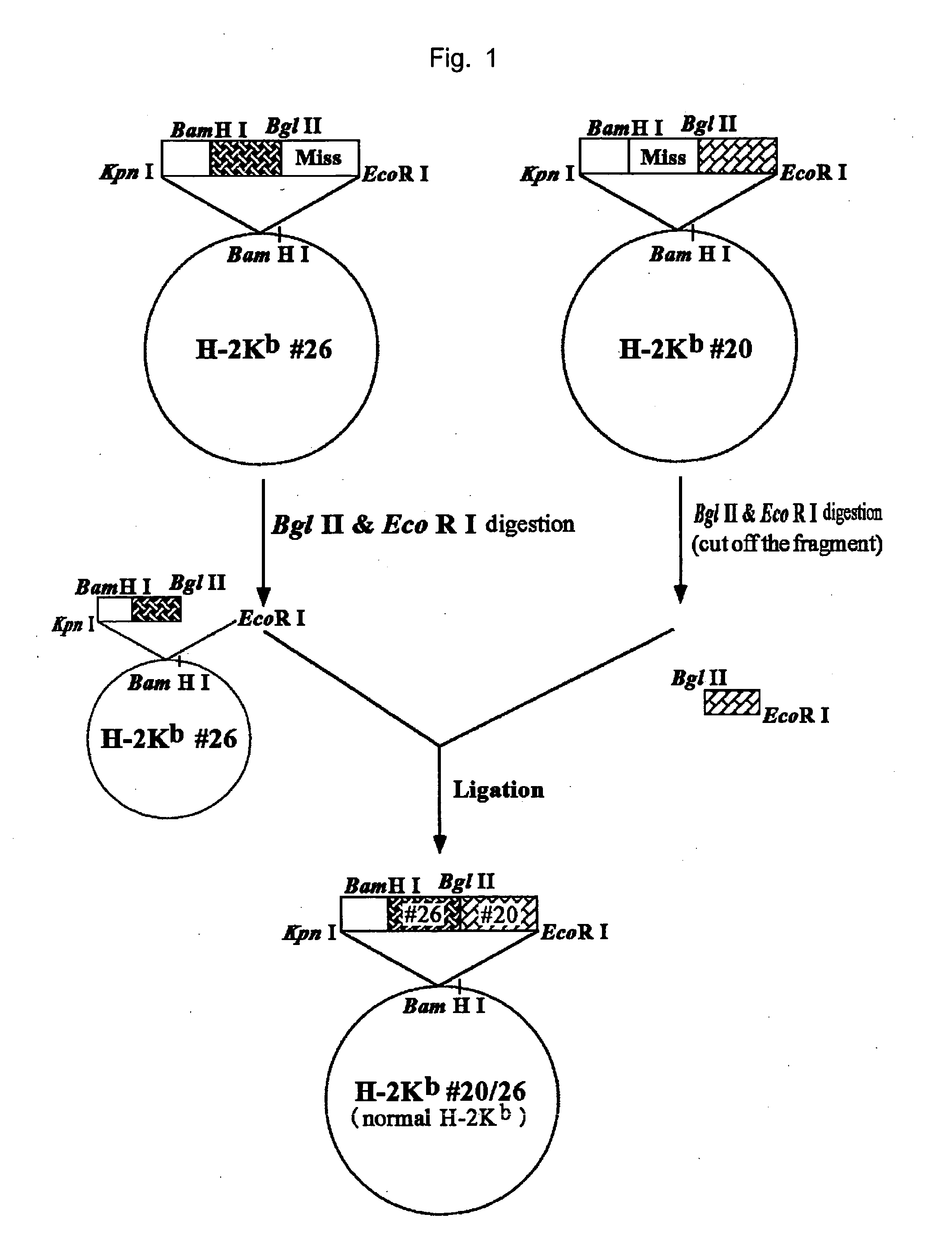Hla-a24-restricted cancer antigen peptides
a cancer antigen and restriction technology, applied in the field of cancer vaccine therapies, can solve the problems of inability to conduct in vivo evaluation of cancer, inability to use pure-line mice commonly used as experimental animals for vaccines, and inability to identify peptides based on binding motif or expected peptide sequences that are not necessarily immunogeni
- Summary
- Abstract
- Description
- Claims
- Application Information
AI Technical Summary
Benefits of technology
Problems solved by technology
Method used
Image
Examples
example 1
CTL-inducing Activities of Natural Peptides Derived from Human WT1 and Altered Peptides
[0251] The amino acid sequence of human WT1 was searched for the sequence expected to bind an HLA-A24 antigen using BIMAS software that is to search for a sequence capable to bind an HLA antigen (http: / / bimas.dcrt.nih.gov / molbio / hla_bind / ). The search identified the following peptides:
peptide A:Arg Met Phe Pro Asn Ala Pro Tyr(SEQ ID NO: 8)Leu,peptide B:Arg Val Pro Gly Val Ala Pro Thr(SEQ ID NO: 7)Leu,peptide C:Arg Trp Pro Ser Cys Gln Lys Lys(SEQ ID NO: 9)Phe,peptide D:Gln Tyr Arg Ile His Thr His Gly(SEQ ID NO: 10)Val Pheandpeptide E:Ala Tyr Pro Gly Cys Asn Lys Arg(SEQ ID NO: 11)Tyr Phe.
[0252] Peptides A, B, C, D, and E correspond to the sequences at positions from 126 to 134, from 302 to 310, from 417 to 425, from 285 to 294, and from 326 to 335 of the amino acid sequence of human WT1, respectively. These peptides were synthesized using Fmoc method.
[0253] Altered peptides wherein the amino ac...
example 2
CTL-inducing Activities of Altered Peptides Derived from Human WT1 (II)
[0259] In a similar manner to Example 1, the following natural peptides (peptides K and L) searched and identified to have the sequence expected to bind an HLA-A24 antigen using BIMAS software, and altered peptides thereof (peptides I and J) wherein the amino acid at position 2 in the natural forms is altered into tyrosine, were synthesized using Fmoc method: [0260] peptide K: Ala Leu Leu Pro Ala Val Pro Ser Leu (SEQ ID NO: 51), [0261] peptide L: Asn Gln Met Asn Leu Gly Ala Tht Leu (SEQ ID NO: 52), [0262] peptide I: Ala Tyr Leu Pro Ala Val Pro Ser Leu (SEQ ID NO: 5), and [0263] peptide J: Asn Tyr Met Asn Leu Gly Ala Thr Leu (SEQ ID NO: 6).
[0264] Peptides K and L correspond to the sequences at positions from 10 to 18, and from 239 to 247 of the amino acid sequence of human WT1, respectively. Peptides I and J are the altered peptides wherein the amino acid at position 2 in peptides K and L is altered into tyrosi...
example 3
Cytotoxic Activities of Altered Peptides Derived from Human WT1
[0267] Cross-reactivity of the effector cells induced by the altered peptide to the natural peptide was tested. Effector cells induced by immunizing the mice with the altered form: peptide H (E) and target cells of the Jurkat-A2402 / Kb cells pulsed with the natural form: peptide C (T) were combined and reacted at an E / T ratio of 80, and the cytotoxic activity was determined by 51Cr release assay. The results are shown in FIG. 20. The figure shows that the effector cells induced by the WT1 altered peptide exhibited a cytotoxic activity against both cells pulsed with the altered and natural forms.
PUM
| Property | Measurement | Unit |
|---|---|---|
| weight | aaaaa | aaaaa |
| weight | aaaaa | aaaaa |
| weight | aaaaa | aaaaa |
Abstract
Description
Claims
Application Information
 Login to View More
Login to View More - R&D
- Intellectual Property
- Life Sciences
- Materials
- Tech Scout
- Unparalleled Data Quality
- Higher Quality Content
- 60% Fewer Hallucinations
Browse by: Latest US Patents, China's latest patents, Technical Efficacy Thesaurus, Application Domain, Technology Topic, Popular Technical Reports.
© 2025 PatSnap. All rights reserved.Legal|Privacy policy|Modern Slavery Act Transparency Statement|Sitemap|About US| Contact US: help@patsnap.com



